BIO 1500: Exam #3 Study Gide
1/85
There's no tags or description
Looks like no tags are added yet.
Name | Mastery | Learn | Test | Matching | Spaced |
|---|
No study sessions yet.
86 Terms
How to test whether high O2 selects for larger body size
LO1
Describe an effective experimental design to determine whether an environmental variable imposes selection on a trait
control constants (temperature, environment, food, etc.); manipulate independent variable(s); record dependent variable(s); keep control group
What is essential for an experimental design that tests a change in phenotype caused by an environmental factor over time?
The experiment needs to run for multiple generations!! This is required to spot an EVOLUTIONARY change
What was the point of moving fruit flies from hyperoxic conditions to normal conditions before measuring the lengths and mass of fruitf lies?
To verify that the larger size is due to genetic change in the population rather than the physiological effects of high oxygen
Recognize the potential of natural selection to cause dramatic changes in phenotype, e.g. body size.
Natural selection can cause microevolution (change in allele frequencies); natural selection occurs when an organism's physical characteristics make it either more or less suited to thrive in an environment. The physical characteristics are called the phenotype; therefore natural selection works directly on the phenotype
Organic Molecules
LO2
Memorize the four classes of organic molecules
Carbohydrates, lipids, proteins, and nucleic acids
If a molecule is described as 'organic,' then which of the following statements must be true?
It contains carbon
Which of the following are examples of carbohydrates?
Glucose, cellulose, chitin
Which of the following are examples of lipids?
Olive oil, bees wax, bacon fat
When a fat is described as ‘saturated,’ what is it saturated with?
Hydrogen
What is the building block for proteins?
Amino acids
What is the building block for carbohydrates?
Simple sugars (fructose, glucose, and lactose)
What is the building block for nucleic acids?
Nucleotides
What is the building block for lipids?
Fatty acids
What are characteristics of saturated fats?
They are solid at room temperature, they have single bonds within the carbon chain, they are usually obtained from animal sources
Saturated fats have all of the following characteristics EXCEPT:
They tend to dissolve in water quicklly
Which of the following foods is likely to contain the most cellulose?
A serving of broccoli
Phospholipids are important components of which cellular structure?
membranes
What is the result of dehydration synthesis?
Two molecules form a chemical bond with each other
Which of the following could be the outcome of hydrolysis?
A starch is broken into simple sugar molecules
How does dehydration synthesis happen?
A water molecule is removed from the reactants
How does hydrolysis happen?
A water molecule is added to the reactants
Biological macromolecules are ____ that are constructed from ______
Polymers
Monomers
Explain the relationship between the terms monomer and polymer
Polymers are made up of monomers which are parts of a molecule while polymers are large molecules that are formed by the bonding of monomers
Functions of carbohydrates
Source of energy for our bodies
Monosaccharides: simple sugars like glucose.
Providing a plant cell structural support
The exoskeleton (protests insects internal body parts) is made out of chiitin
Functions of lipids
Largely non polar
Non polar molecules are hydrophobic or insoluble in water
Cells store energy for long-term use in the form of fats (naked and afraid transformations)
Provide insulation from the environment for plants and animals
Keep aquatic birds and mammals dry by forming a protective layer over fur or feathers because they are hydrophobic
When the hydrocarbon chain of a lipid contains a double bond, the fatty acid is ___
unsaturated
What covers some aquatic birds; feathers and some plants’ leaf structure to prevent water from sticking to the surface
Wax
Functions of Proteins
Synthesize enzymes
Hormones are chemical-signaling molecules, usually small proteins or steroids, secreted by endocrine cells that act to control or regulate specific physiological processes, including growth, development, metabolism, and reproduction.
Diverse range of functions — they may serve in transport, storage, or membranes; or they may be toxins or enzymes
Proteins have different shapes and molecular weights
Denaturation
Denuaturation
Changes in temperature, pH, and exposure to chemicals may lead to permanent changes in the proteins’s shape, leading to loss of function
Functions of Nucleic Acids
The most important macromolecules for the continuity of life. They carry the cell’s genetic blueprint and carry instructions for its functioning.
Explain why most cells are limited to a small size
Small cell size allows ions and organic molecules that enter them, to quickly diffuse to other parts of the cell. This also applies to waste produced within the cell. Moreover, as a cell increases in size, its surface area-to-volume ratio decreases. If the cell grows too large, the plasma membrane doesn’t have sufficient surface area to support the rate of diffusion required for the increased volume of the cell. In short, as the cell grows, it becomes less efficient.
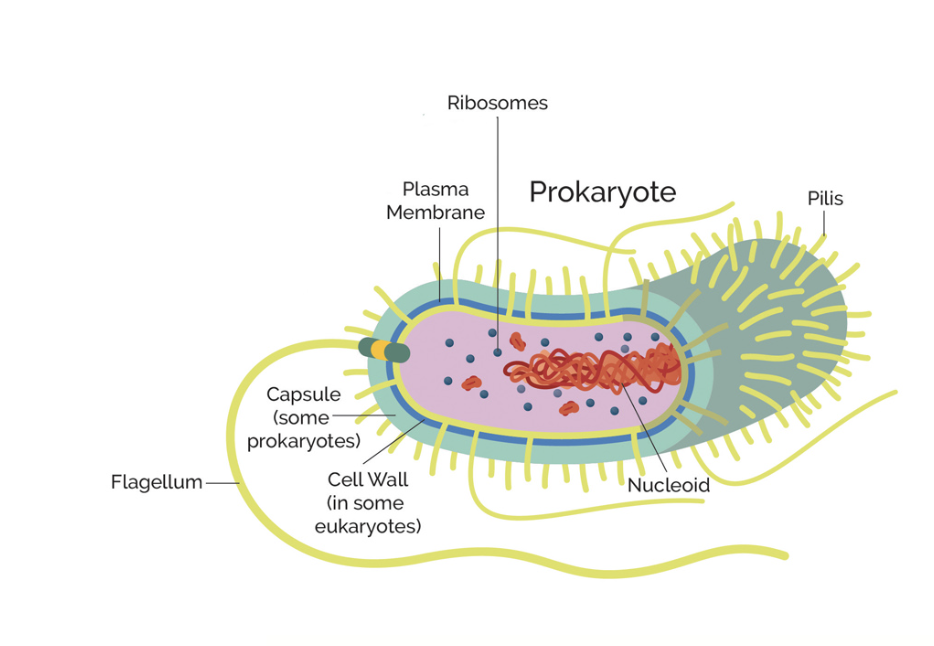
What makes prokaryotes unique
Prokaryotes do not have a nucleus. Instead, prokaryote DNA can be found, bundled but free-floating, in a central region called the nucleoid. Prokaryote DNA is usually found as a single chromosome of circular DNA. These organisms also lack other membrane-bound structures such as the endoplasmic reticulum, mitochondria, and the nucleus.
Prokaryotes can be split into two domains
Bacteria and archea
What is inside a prokaryotic cell
Nucleoid: A central region of the cell that contains its DNA.
Ribosome: Ribosomes are responsible for protein synthesis.
Cell wall: The cell wall provides structure and protection from the outside environment. Most bacteria have a rigid cell wall made from carbohydrates and proteins called peptidoglycans.
Cell membrane: Every prokaryote has a cell membrane, also known as the plasma membrane, that separates the cell from the outside environment.
Capsule: Some bacteria have a layer of carbohydrates that surrounds the cell wall called the capsule. The capsule helps the bacterium attach to surfaces.
Fimbriae: Fimbriae are thin, hair-like structures that help with cellular attachment.
Pili: Pili are rod-shaped structures involved in multiple roles, including attachment and DNA transfer.
Flagella: Flagella are thin, tail-like structures that assist in movement.
List some organelles in eukaryotes
Nucleus: The nucleus stores the genetic information in chromatin form.
Nucleolus: Found inside of the nucleus, the nucleolus is the part of eukaryotic cells where ribosomal RNA is produced.
Plasma membrane: The plasma membrane is a phospholipid bilayer that surrounds the entire cell and encompasses the organelles within.
Cytoskeleton or cell wall: The cytoskeleton or cell wall provides structure, allows for cell movement, and plays a role in cell division.
Ribosomes: Ribosomes are responsible for protein synthesis.
Mitochondria: Mitochondria, also known as the powerhouses of the cell, are responsible for energy production.
Cytoplasm: The cytoplasm is the region of the cell between the nuclear envelope and plasma membrane.
Cytosol: Cytosol is a gel-like substance within the cell that contains the organelles.
Endoplasmic reticulum: The endoplasmic reticulum is an organelle dedicated to protein maturation and transportation.
Vesicles and vacuoles: Vesicles and vacuoles are membrane-bound sacs involved in transportation and storage.
Examples of eukaryotes
Animals, plants, fungi, algae and protozoans
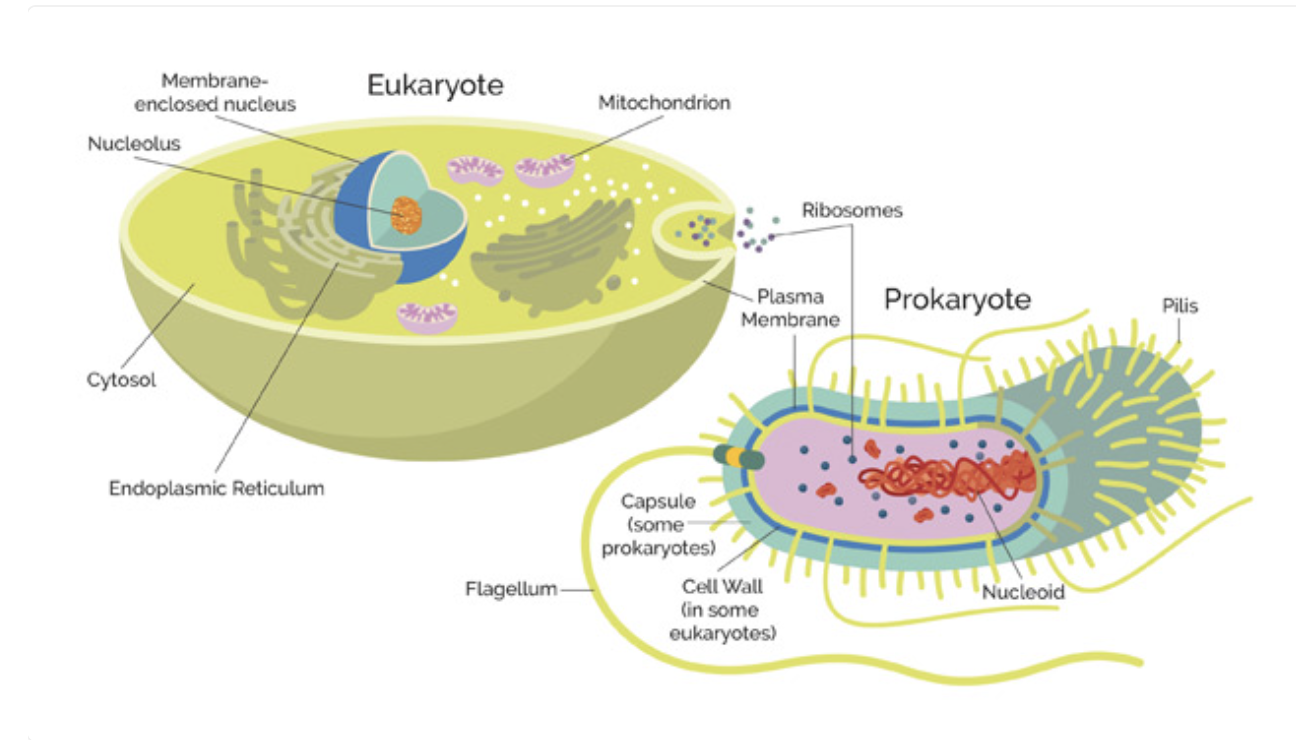
What are the structural differences between prokaryote and eukaryote cells?
The primary distinction between these two types of organisms is that eukaryotic cells have a membrane-bound nucleus and prokaryotic cells do not. The nucleus is where eukaryotes store their genetic information. In prokaryotes, DNA is bundled together in the nucleoid region, but it is not stored within a membrane-bound nucleus.
The nucleus is only one of many membrane-bound organelles in eukaryotes. Prokaryotes, on the other hand, have no membrane-bound organelles.
DNA structure. Eukaryote DNA consists of multiple molecules of double-stranded linear DNA, while that of prokaryotes is double-stranded and circular.
Key similarities between prokaryotes and eukaryotes
DNA
Cell/ plasma membrane
Cytoplasm
Ribosomes
Cytoskeleton
Cell Wall (plants and protists’)
acts as a layer of protection, helps the cell maintain its shape, and prevents dehydration. The major organic molecule in plants (and some protists’) is cellulose (composed of carbohydrates)
Plasma/ Cell Membrane
A phospholipid bilayer with embedded proteins separates the internal contents of the cell from its surrounding environment. A phospholipid is a lipid molecule with two fatty acid chains and a phosphate-containing group. The plasma membrane controls the passage of organic molecules, ions, water, and oxygen into and out of the cell.
Present in prokaryotes, animal cells, and plant cells
Mitochondria
ATP production/cellular respiration
Present in plant and animal cells
Choloroplast
Photosynthesis
Present in plant cells
Golgi apparatus
Modifies, sorts, tags, packages, and distributes lipids and proteins
The transport vesicles that form from the ER travel to the cis face, fuse with it, and empty their contents into the Golgi apparatus' lumen. As the proteins and lipids travel through the Golgi, they undergo further modifications that allow them to be sorted.
Finally, the modified and tagged proteins are packaged into secretory vesicles that bud from the Golgi's trans face. While some of these vesicles deposit their contents into other cell parts where they will be used, other secretory vesicles fuse with the plasma membrane and release their contents outside the cell.
Present in plant and animal cells
Ribosomes
Protein synthesis
Appear as clusters or single, tiny dots that float freely in the cytoplasm
May be attached to the plasma membrane’s cytoplasmic side or the endoplasmic reticulum’s cytoplasmic side and the nuclear envelope’s outer membrane
Ribosomes receive their “orders” for protein synthesis from the nucleus where the DNA transcribes into messenger RNA (mRNA)--> The mRNA travels to the ribosomes, which translate the code provided by the sequence of the nitrogenous bases in the mRNA into a specific order of amino acids in a protein
Present in plant and animal cells, and prokaryotes
Nucleus
A cell organelle that houses DNA and directs the synthesis of ribosomes and proteins
Replication and transcription take place here
Present in plant and animal cells
Flagella
Cellular locomotion
Mostly found in protists
Cytoskeleton
Maintains cell’s shape, secures organelles in specific positions, allows cytoplasm and vesicles to move within the cell, and enables unicellular organisms to move independently
Composed of microfilaments, intermediate filaments, and microtubules
Observed in prokaryotes, animal and plant cells
Endoplasmic Reticulum
Modifies proteins and synthesizes lipids.
RER— Region of the endoplasmic reticulum that is studded with ribosomes and engages in protein modification and phospholipid synthesis
SER—Region of the endoplasmic reticulum that has few or no ribosomes on its cytoplasmic surface and synthesizes carbohydrates, lipids, and steroid hormones; detoxifies certain chemicals (like pesticides, preservatives, medications, and environmental pollutants), and stores calcium ions
Lysosome
Are the cell’s “garbage disposal.”
Organelle in an animal cell that functions as the cell’s digestive component; it breaks down proteins, polysaccharides, lipids, nucleic acids, and even worn-out organelles.
Present in animal cells
Endomembrane System
1. synthesis of proteins and transport into membranes, organelles, or out-of-cells
2. Metabolism and movement of lipids
3. Detoxification of poisons
Nuclear Envelope, Plasma Membrane, Endoplasmic Reticulum, Golgi Apparatus, Lysosomes, and Vacuoles
Present in animal and plant cells
Vesicle
Membrane-bound sacs that function in storage and transport. Vesicle membranes can fuse with either the plasma membrane or other membrane systems within the cell. They can also absorb and destroy toxic substances and pathogens to prevent cell damage and infection.
Animal cells
Vacuole
Membrane-bound sacs that function in storage and transport. Vacuoles are somewhat larger than vesicles and share the same function.
In plant cells, they help maintain water balance
Found in plant cells
Plant and Animal Cell Differences
Plant cells have a cell wall that provides support, animal cells don't
Plant cells have chloroplasts for photosynthesis, animal cells don't
Plant cells are more rectangular, and animal cells are more rounded
Plant cells use chloroplasts to store energy/sugar, and animal cells use mitochondria to release energy stored in food
Plant cells have one huge vacuole, and animal cells have several small ones
Plant cells lack lysosomes, animal cells have these.
Cellular respiration and fementation
LO4
Identify the function of cellular respiration
To produce ATP
What are the inputs of cellular respiration
Glucose + O2
What are the products of cellular respiration
ATP + CO2 + H2O
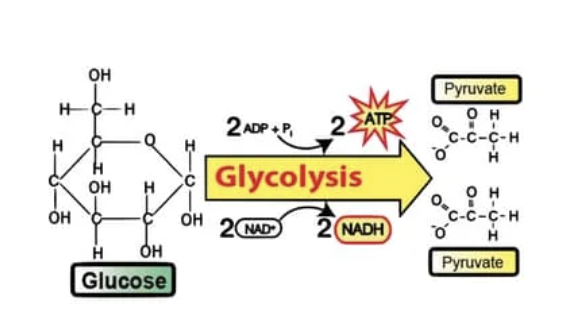
Glycolysis
Step 1 of CR
Glucose is broken into pyruvate, yielding 2 ATP & some NADH
The 6 carbon sugar is broken into 2, 3 carbon molecules
Citric acid cycle/ Krebs Cycle
Step 2 of CR
pyruvate is further broken down; the energy from its chemical bonds ends up in NADH, FADH2, and some ATP. CO2 is released as a by-product.
The energized electrons from NADH and FADH2 then enter an ETC
Electron transport chain
Step 3 of CR
E- are supplied by NADH and FADH2
As the electron is passed from protein to protein, it moves to a lower energy state; the energy is used to pump H+ (protons) across the membrane, generating a proton gradient that stores energy
O2 is the FINAL ACCEPTOR of the electrons, producing H2O as a byproduct
H+ re-enters the mitochondrial matrix (inner part of the mitochondria) through ATP synthase (enzyme), generating ATP
Although some ATP (2) is produced during glycolysis, more is produced (34) from the ETC
What are the byproducts of cellular respiration?
H2O (from O2 culminating at the end of the chain) and CO2 (Krebs)
What is the role of proteins in the electron transport chain?
During electron transfer, proteins in the electron transport chain complexes pump the protons in the mitochondrial matrix to the intermembrane space. The accumulated protons in the intermembrane space generate proton gradients across the inner mitochondrial membrane. All of the protons are positively charged, and like charges repel each other, therefore it requires energy to force more protons into the intermembrane space and protons will move out of the space through ATP synthase. The energy the concentration gradient stores is used to attach phosphate groups to ADP to create ATP.
What is the role of O2 in the ETC?
O2 is the final electron acceptor. As the electrons move from protein to protein, they eventually interact with molecules of O2 and form H2O
Explain the reason for cell death in the absence of O2.
If that O2 is not present, then the entire process stops. The ETC stops, and we don’t get the protons being pumped into the intermembrane space. Therefore there would be no potential energy stored in the intermembrane space, and ATP could not be synthesized
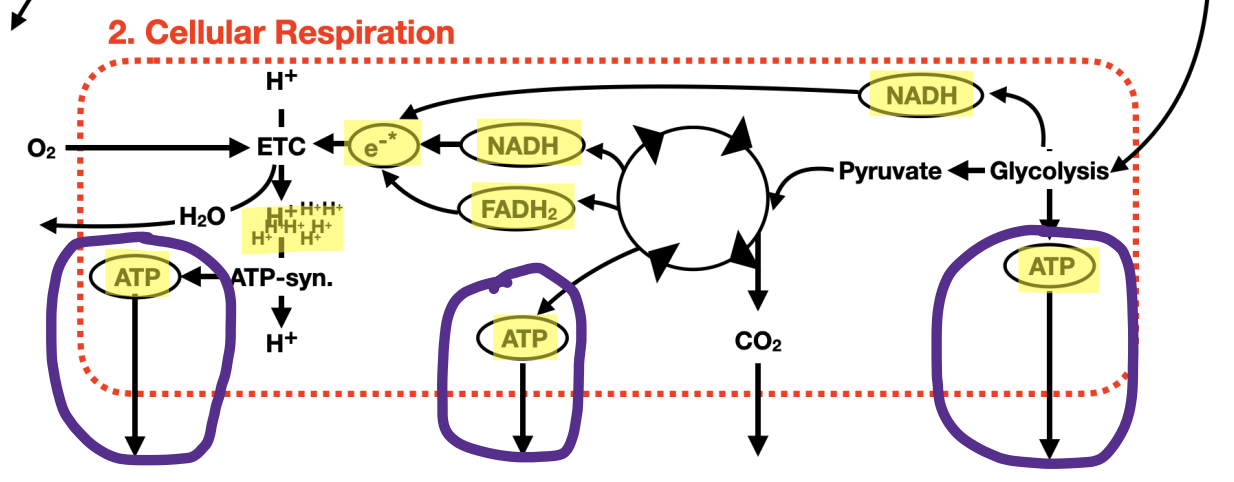
Trace the flow of energy through the steps of cellular respiration
During cellular respiration, energy is released from glucose, and that energy helps make adenosine triphosphate (ATP).
The energy begins in the glucose bonds. Then it is transferred to NADH and FADH2 as a result of pyruvate prep/the citric acid cycle. Finally, the NADH and FADH2 are used in the electron transport chain (energy from the electrons), and this energy is used to create the H+ concentration gradient. The H+ gradient stores potential energy, and since the positive charges repel, it forces the proteins down ATP synthase, where the energy is finally captured in ATP.
Glucose —> ATP in glycolysis —> NADH, FADH2, ATP —→ electrons —→ proton gradient —→ ATP
Explain how fermentation differs from cellular respiration and the situations in which it occurs
This occurs because there are scenarios in which there is no oxygen. Pyruvate undergoes fermentation instead of the citric acid cycle
Deep in soil
In the guts of animals
When an organism requires too much energy
Memorize the outputs of fermentation
Alcohol & CO2
Lactic Acid
Glycolysis still occurs in ______, and it still produces ____ ATP
Fermentation
2
How is fermentation cyclical?
It generates NAD+, and NAD+ is the molecule that will receive the H to become NADH during glycolysis. We must have NAD+ in order for glycolysis to occur because there has to be some molecule available to receive the H
In which way do cells use glucose during the production of ATP? Choose one.
Cells transfer some of the energy stored in glucose’s chemical bonds to ATP.
Photosynthesis LO5
Explain your observations of reddish light coming from Chlorophyll when lit with white light. Include a description of fluorescence in your explanation
When the bright white light hits the chlorophyll, the energy in the photons from the light is absorbed and 'excites' electrons in the chlorophyll to a higher energy state. However, the electron then quickly drops back down to the ground state, releasing the energy as light, usually of a longer wavelength, otherwise known as fluorescence.
Explain why chlorophyll in a leaf behaves differently than isolated chlorophyll.
Plants have chloroplasts that contain chlorophyll. The electrons are “caught” by the electron transport chain, and that energy is used. The energy is converted into chemical energy (ATP). The vile of chlorophyll lacks a light-capturing complex, so the energy simply falls back to the solution.
Comparing cell. resp. and photosynthesis
LO5
Identify the common features between CR and Photosynthesis
Both involve the electron transport chain
Proton gradient — E from the electrons is used to pump protons across a membrane
Make use of each other’s byproducts. CR: H2O and CO2, PS: O2
Both utilize ATP synthase
Both have electron carriers (FADH2 & NADH in CR) (e- from H2 in PS)
Both produce ATP (PS- light-dependent, CR- glycolysis)
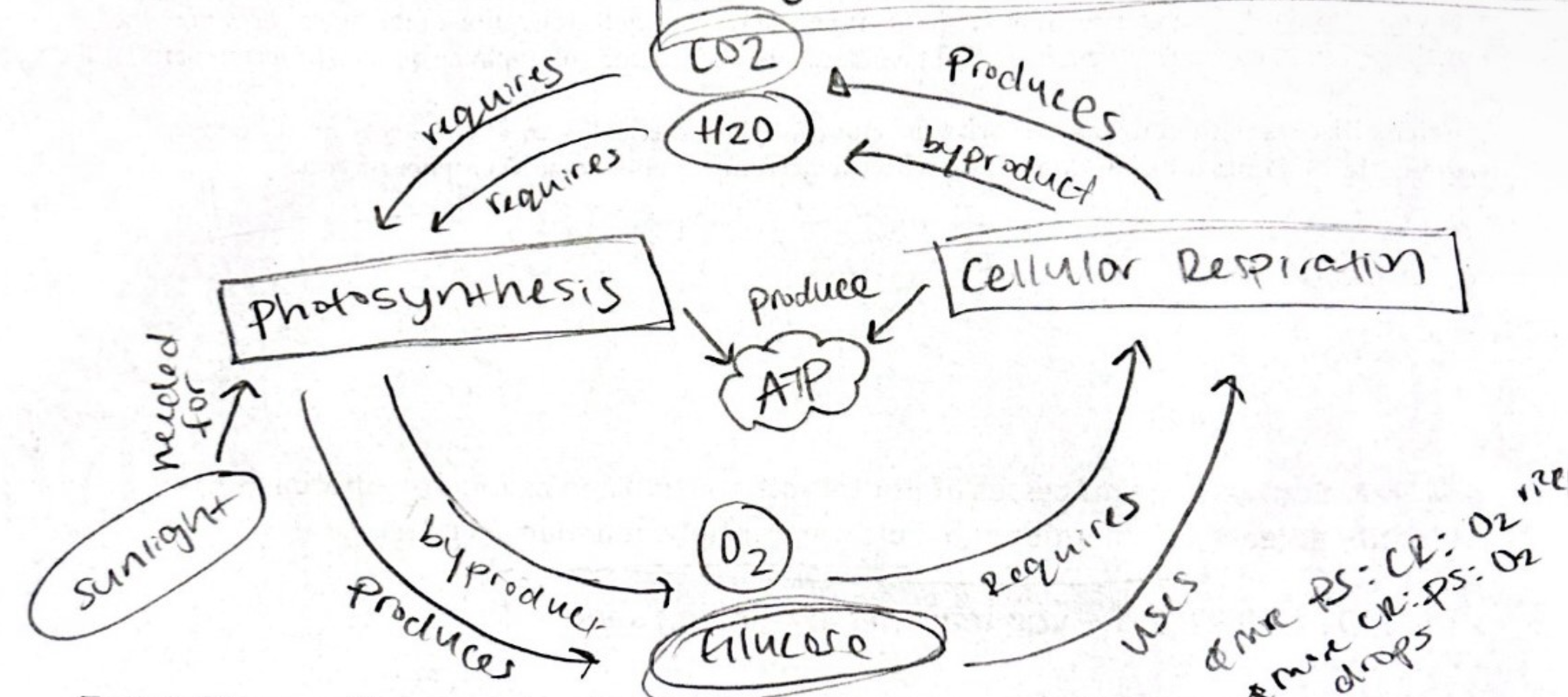
Identify the differences between CR and Photosynthesis
CR- goal to produce ATP, Ps- goal is to produce glucose
CR inputs O2, PS outputs O2
Location of chemical reaction: PS- chloroplasts, CR- mitochondria
Final acceptor of e- in each: PS- NADO+ (makes NADPH), CR- O2
Recognize the inter-relationship between CR & PS
Photosynthesis converts carbon dioxide and water into oxygen and glucose. Glucose is used as food by the plant and oxygen is a by-product. Cellular respiration converts oxygen and glucose into water and carbon dioxide. Water and carbon dioxide are by-products and ATP is energy that is transformed from the process.
Enzymes, ATP synthase, and Ion Gradients
LO6
What are enzymes
they lower the activation energy required for reactions and thereby speed up the rate of reactions, without being used up themselves.
Proteins made of amino acids
Explain the general mechanism of how enzymes function
Substrate enters the active site (little pocket) of the enzyme
Substrate molecules react with each other and then the substrate forms bond
Bonded substrates leave enzyme
Explain what determines the specificity of enzymes for the reactions they catalyze
The specificity is determined by the shape of the enzyme. Only a few substrate molecules of a certain shape can fit into the enzyme. Enzymes are specific to one substrate molecule because they have an active site that is complementary to that substrate and no others. No other substrates will fit into that active site so no other reactions will be catalyzed. Remember, enzymes are proteins. We have previously learned that the function of proteins changes dramatically when their shape changes.
What is ATP Synthase
An enzyme! Enzymes bring reactants together so they don’t have to expend energy moving about until they collide at random
H+ pushing inward rotates F0. The rotation pushes ADP and phosphate together and they form a bond = ATP. 12 protons are required for one rotation, and for 1 rotation, 3 ATP’s are formed
ATP-syntahse: ADP + Pi (phosphate) + energy → ATP
Recall the general function that gradients serve in cells.
Gradients store potential energy that the cell can use to do biological work
Recall two additional examples of how gradients in cells are used to do work.
Diffusion
???